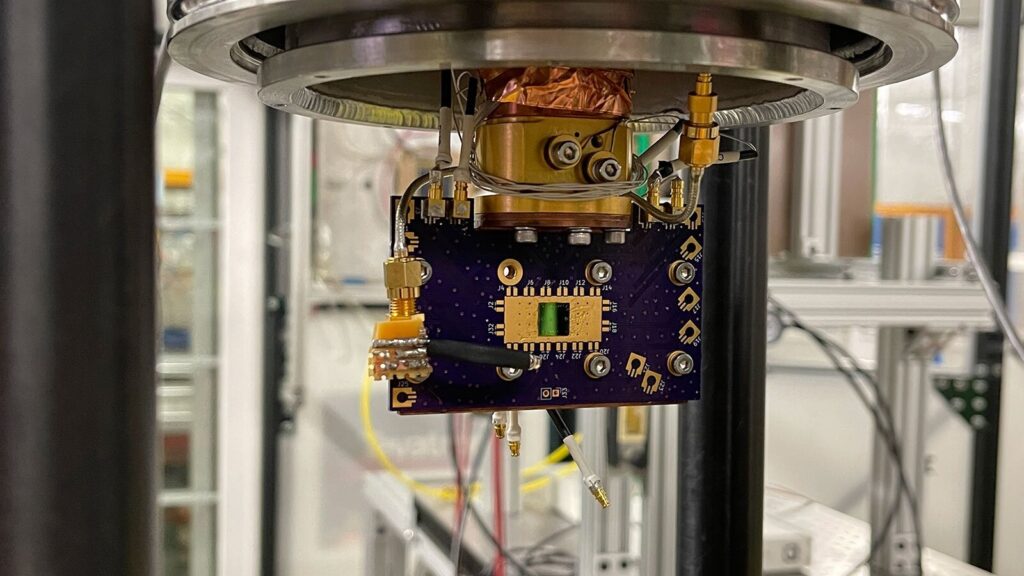Particle detectors play a crucial role in our understanding of the fundamental building blocks of the universe. They allow scientists to study the behavior and properties of the particles produced in high-energy collisions. Such particles are boosted to near the speed of light in large accelerators and then smashed into targets or other particles where they are then analyzed with detectors. Traditional detectors, however, lack the needed sensitivity and precision for certain types of research.
Researchers at the U.S. Department of Energy’s (DOE) Argonne National Laboratory have made a significant breakthrough in the field of high-energy particle detection in recent experiments conducted at the Test Beam Facility at DOE’s Fermi National Accelerator Laboratory (Fermilab).
They have found a new use for the superconducting nanowire photon detectors (SNSPDs) already employed for detecting photons, the fundamental particles of light. These incredibly sensitive and precise detectors work by absorbing individual photons. The absorption generates small electrical changes in the superconducting nanowires at very low temperatures, allowing for the detection and measurement of photons. Specialized devices able to detect individual photons are crucial for quantum cryptography (the science of keeping information secret and secure), advanced optical sensing (precision measurement using light) and quantum computing.
The work is published in the journal Nuclear Instruments and Methods in Physics Research Section A: Accelerators, Spectrometers, Detectors and Associated Equipment.
In this study, the research team discovered that these photon sensors could potentially also function as highly accurate particle detectors, specifically for high-energy protons used as projectiles in particle accelerators. Found in the atomic nucleus of every element, the proton is a particle with a positive electrical charge.
The team’s breakthrough opens up exciting opportunities in the field of nuclear and particle physics.
“This was a first-of-its-kind use of the technology,” said Argonne physicist Whitney Armstrong. “This step was critical to demonstrate that the technology works the way we want it to because it is typically geared toward photons. It was a key demonstration for future high-impact applications.”
The team made SNSPDs with different wire sizes and tested them with a beam of 120 GeV protons at Fermilab, which was the nearest facility equipped to carry out this experiment. These high-energy protons are important because they allow researchers to simulate and study the conditions under which SNSPDs might operate in high-energy physics experiments, providing valuable insights into their capabilities and limitations.
The researchers found that wire widths smaller than 400 nanometers—the width of a human hair is approximately 100,000 nanometers—demonstrated the high detection efficiency needed for high-energy proton sensing. Further, the study also revealed an optimal wire size of approximately 250 nanometers for this application.
In addition to their sensitivity and precision, SNSPDs also operate well under high magnetic fields, making them suitable for use in the superconducting magnets used in accelerators to boost particle velocity. The ability to detect high-energy protons with SNSPDs has never been reported before, and this breakthrough widens the scope of particle detection applications.
“This was a successful technology transfer between quantum sciences, for photon detection, into experimental nuclear physics,” said Argonne physicist Tomas Polakovic. “We took the photon-sensing device and made slight changes to make it work better in magnetic fields and for particles. And behold, we saw the particles exactly as we expected.”
This work also demonstrates the feasibility of the technology for use in the Electron-Ion Collider (EIC), a cutting-edge particle accelerator facility being built at DOE’s Brookhaven National Laboratory. The EIC will collide electrons with protons and atomic nuclei (ions) to get a better look at the internal structure of those particles, including the quarks and gluons that make up the protons and neutrons of nuclei.
The EIC requires sensitive and precise detectors, and SNSPDs will be valuable tools for capturing and analyzing the resulting particles produced in collisions within the EIC.
“The proton energy range that we tested at Fermilab is right in the middle of the span of the ion’s energy range that we will detect at EIC, so these tests were well-suited,” said Sangbaek Lee, a physics postdoctoral appointee at Argonne.
The research team made use of the Reactive Ion Etching tool at the Center for Nanoscale Materials, a DOE Office of Science user facility at Argonne. Other contributors to this work include Alan Dibos, Timothy Draher, Nathaniel Pastika, Zein-Eddine Meziani and Valentine Novosad.


